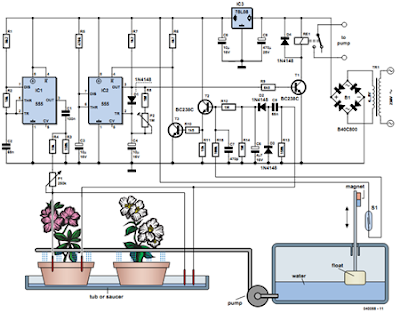The principle of the circuit is simple: first the soil dampness is measured by passing a signal through two electrodes placed in the soil. The moisture content is inversely proportional to the measured resistance. When this measurement indicates it is too dry, the plants are given a predefined dose of water. This last part is important for the correct function of the automatic watering can because it takes a little while for the soil to absorb the water dose and for its resistance to fall. If the water were allowed to flow until the soil resistance drops then the plant would soon be flooded.
An Electronic Watering Can Circuit Diagram
The circuit shows two 555 timer chips IC1 and IC2. IC1 is an astable multivibrator producing an ac coupled square wave at around 500 Hz for the measurement electrodes F and F1. An ac signal reduces electrode corrosion and also has less reaction with the growth-promoting chemistry of the plant. Current flowing between the electrodes produces a signal on resistor R13. The signal level is boosted and rectified by the voltage doubler produced by D2 and D3. When the voltage level on R13 is greater than round 1.5 V to 2.0 V transistor T2 will conduct and switch T3. Current flow through the soil is in the order of 10 µA.
T2 and T3 remain conducting providing the soil is moist enough. The voltage level on pin 4 of IC2 will be zero and IC2 will be disabled. As the soil dries out the signal across R13 gets smaller until eventually T2 stops conducting and T3 is switched off. The voltage on pin 4 of IC2 rises to a ‘1’ and the chip is enabled. IC2 oscillates with an ‘on’ time of around 5 s and an ‘off’ time (adjustable via P2) of 10 to 20 s. This signal switches the water pump via T1. P1 allows adjustment of the minimum soil moisture content necessary before watering is triggered.
The electrodes can be made from lengths of 1.5 mm2 solid copper wire with the insulation stripped off the last 1 cm. The electrodes should be pushed into the earth so that the tips are at roughly the same depth as the plant root ball. The distant between the electrodes is not critical; a few centimetres should be sufficient. The electrode tips can be tinned with solder to reduce any biological reaction with the copper surface. Stainless steel wire is a better alternative to copper, heat shrink sleeving can used to insulate the wire with the last 1 cm of the electrode left bare. Two additional electrodes (F1) are con nected in parallel to the soil probe electrodes (F). The F1 electrodes are for safety to ensure that the pump is turned off if for some reason water collects in the plant pot saucer. A second safety measure is a float switch fitted to the water reservoir tank.
When the water level falls too low a floating magnet activates a reed switch and turns off the pump so that it is not damaged by running with a dry tank. Water to the plants can be routed through closed end plastic tubing (with an internal diameter of around 4 to 5 mm) to the plant pots. The number of 1 mm to 1.5 mm outlet holes in the pipe will control the dose of water supplied to each plant. The soil probes can only be inserted into one flowerpot so choose a plant with around average water consumption amongst your collection. Increasing or decreasing the number of holes in the water supply pipe will adjust water supply to the other plants depending on their needs. A 12 V water pump is a good choice for this application but if you use a mains driven pump it is essential to observe all the necessary safety precautions.
Last but not least the electronic watering can is too good to be used just for holiday periods, it will ensure that your plants never suffer from the blight of over or under-watering again; provided of course you remember to keep the water reservoir topped up…

